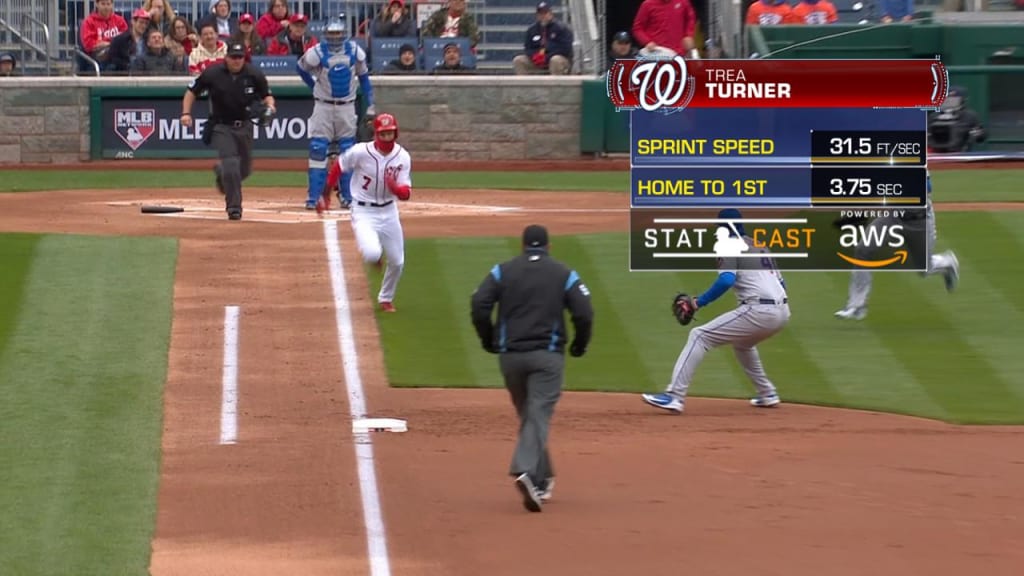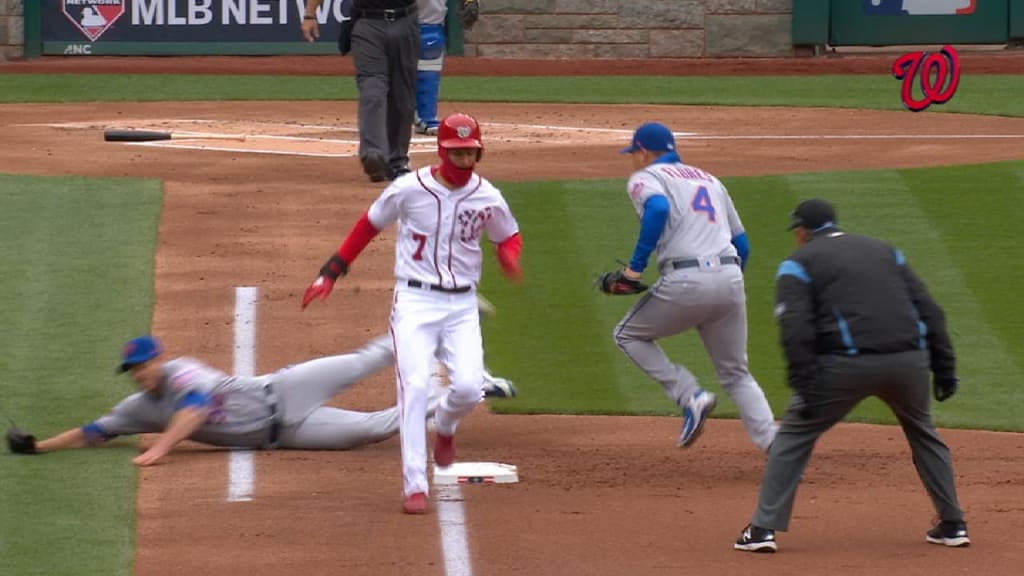Trea Turner shoots up new speed leaderboard
This browser does not support the video element.
When we first introduced "Sprint Speed" last year, it was the first time directly measured data on the top speed of runners was available, and most of the results reflected exactly what your eyes told you. Byron Buxton and Billy Hamilton were at the top, around 30 feet per second at their fastest -- well ahead of the league average of 27 feet per second. The bottom of the list was comprised almost entirely of catchers and designated hitters, getting only to around 23 feet per second. No shock there, either.
The main surprise was that Trea Turner wasn't at the top with Buxton and Hamilton, since he's considered to have elite speed. He was extremely good, of course; at 29.3 feet per second, he ranked 11th of more than 460 qualified players and in the 97th percentile. That's fantastic, and yet it still wasn't as satisfying as many would have liked.
As we roll out 2018's leaderboards, you'll notice that Buxton is again at the top. Chicago's Adam Engel is second, and that makes sense, too. In the Minors, he had four seasons with at least 30 steals, topping out at 65 in 2015. But you'll also notice that Turner has now jumped into the top three, tied with Hamilton. That's a lot closer to where everyone expected he'd be, based on his reputation.
2018 Sprint Speed leaders
30.5 feet per second -- Buxton, Twins
30.0 feet per second -- Engel, White Sox
29.9 feet per second -- Turner, Nationals
29.9 feet per second -- Hamilton, Reds
29.8 feet per second -- Dee Gordon, Mariners
29.8 feet per second -- Trevor Story, Rockies
29.7 feet per second -- Derek Fisher, Astros
29.4 feet per second -- Scott Kingery, Phillies
29.3 feet per second -- Tim Anderson, White Sox
29.3 feet per second -- Mallex Smith, Rays
Major League average -- 27 feet per second
The initial reaction is going to be that Turner "got faster," but we'd actually caution you against that. We improved the Sprint Speed metric, based on what we learned in its first year -- in order to make it more useful, more quickly.
This browser does not support the video element.
Measuring speed isn't hard, but measuring speed when it matters is actually quite difficult, because how fast a guy jogs on a lazy fly ball doesn't really tell you much. Last season, in order to get to plays where a runner was very likely to have been trying hard, we looked simply at non-homer plays where a player ran at least two bases (excluding being on second for an extra-base hit, since those are easy to jog home on). Sprint Speed looks at feet per second in a player's fastest one-second window, and those plays are very likely to have a runner "trying" for at least one second.
We took the top 50 percent of those "qualified runs," and we averaged them to get our seasonal average Sprint Speed. It was relatively simple, and it worked well for an initial rollout.
This season, we wanted to include more types of plays, both to get more useful information about players, and to allow more players to qualify for the leaderboards more quickly. So for 2018, a player's seasonal Sprint Speed now includes home-to-first times, drawn only from balls defined as "topped" or "weakly hit," because those are the types of plays likely to require serious effort from the runner. For those, based on the story the data told, we're taking the average of the top 70 percent. (There's also a minor regression built in, explained in more detail here.)
The upshot of all this is that on our two types of qualified runs (two-base runs and home-to-first on weakly hit or grounded balls), we're using approximately two-thirds of them to include in the seasonal average. The second effect is that because this change goes back to previous seasons, numbers since 2015 will change slightly. For an overwhelming majority of players -- 94 percent of 2017's qualifiers -- the change is minor, on the order of fractions of a foot per second.
This browser does not support the video element.
For a small handful, the change is a foot per second or more. That includes Turner, whose 2017 Sprint Speed number jumped from a very good 29.3 feet per second to a truly elite 30.3 feet per second -- good enough to move him into the top 5 of last year's rankings.
Why? Because looking specifically at speed on home-to-first plays (again, just the weakly hit and pounded into the ground balls), Turner was Buxton-esque last year.
2017 Sprint Speed leaders, home-to-first (on topped/weak only)
31.2 feet per second -- Buxton, Twins
31.2 feet per second -- Turner, Nationals
31.0 feet per second -- Engel, White Sox
30.8 feet per second -- Delino DeShields, Rangers
30.8 feet per second -- Magneuris Sierra, Cardinals
30.6 feet per second -- Hamilton, Reds
30.6 feet per second -- Smith, Rays
While Turner was outstanding on two-base runs last year, with that 29.2 feet per second average, he was elite trying to beat out infield hits (31.2 feet per second), and second behind Buxton in 2016, as well. Including that separate skill helps his speed overall, and it's another step on the path to understanding that there are a few different ways to be fast.
You can see that illustrated if we compare Turner to a relatively average runner like Eric Hosmer. The point in the image below isn't to show that Turner is faster than Hosmer, because we know that he is. It's to show that regardless of whether Hosmer is running two or more bases (orange), or to first on weakly hit or topped balls (blue), he basically is what he is. There's not a lot of distinction in the way he runs.
For Turner, however, he's shown himself to be much faster trying to get down the line to first (blue) than he is when he's running multiple bases (orange), and that might be because he knows he's got elite speed, so he tries harder to get to it than an average runner does. We're learning that different players run their best at different points.
It's a small but important step toward getting where we want to go, which is to be able to express all of the different parts of a runner's game, including burst and explosiveness.
Elsewhere on the top of the leaderboard, you'll see names you expect -- Gordon, Hamilton, Starling Marte and others -- and the bottom again is comprised entirely of catchers, first basemen and designated hitters. (You can find Shohei Ohtani at 27.9 feet per second, above the league average, and the best of any designated hitter, which is how he's classified.)
If there's a surprising name on the top 10 list, it might actually be Kingery, the rookie slugging sensation for the Phillies. Then again, Kingery did steal 30 bases in the Minors in 2016, and he was given a 70 "run" grade (on the 20-80 scouting scale) by FanGraphs, so perhaps that's not so unexpected. Already impressing in Philadelphia, Kingery may show he possesses yet another plus tool.
This browser does not support the video element.
You might be similarly surprised to see Story, currently appearing fifth on the list, ahead of even Gordon. Story also gets a bit of a boost from the new method, adding 0.5 feet per second in 2017, and he's probably faster than you think. He had five double-digit steal seasons in the Minors, and going back to 2016, he's hit .342 on grounders. That's tied with Buxton, and it's top five in the Majors. Story's wheels are for real.
It's still early, of course. It's early enough that Ryan Flaherty is leading the National League in batting average, and that Shin-Soo Choo has hit a ball further than Aaron Judge has. There's so much time for things to change. But in the same way that you don't need to see very many fastballs from Noah Syndergaard to know that he throws hard, you don't need to see all that many runs to know if a player is fast. Buxton has elite speed. So does Turner. But you already knew that.

